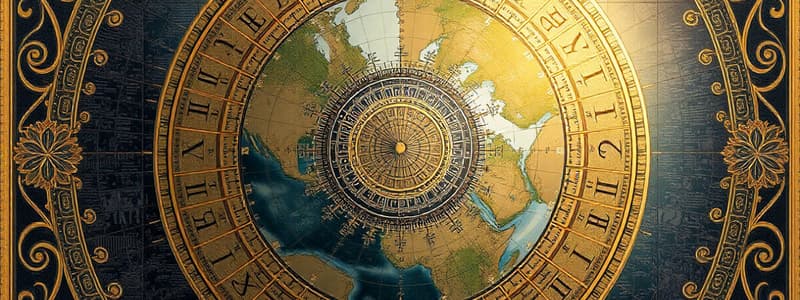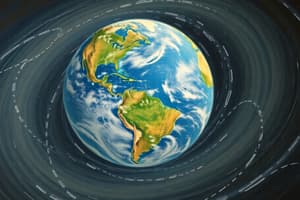Podcast
Questions and Answers
What primary phenomenon leads to the necessity of having different time zones around the world?
What primary phenomenon leads to the necessity of having different time zones around the world?
- The varying speeds at which people travel across the globe.
- The Earth's revolution around the sun causing seasonal changes.
- The Earth's rotation on its axis, leading to varying sunlight exposure. (correct)
- The elliptical orbit of the Earth, affecting the length of the day.
If there were only one time zone, what inconvenience would people experience?
If there were only one time zone, what inconvenience would people experience?
- Global communication systems would fail to synchronize.
- Solar eclipses would occur more frequently in certain areas.
- The international date line would shift unpredictably.
- Noon (12 pm) would not align with the sun's position in all locations. (correct)
How many degrees does the Earth rotate in one hour, and how was this information used to create time zones?
How many degrees does the Earth rotate in one hour, and how was this information used to create time zones?
- 15 degrees; dividing the planet into 24 sections. (correct)
- 20 degrees; calculating daylight savings offsets
- 10 degrees; adjusting time zones based on population density.
- 30 degrees; dividing the planet into 12 sections.
Why are time zones divided into sections that are approximately 15 degrees wide?
Why are time zones divided into sections that are approximately 15 degrees wide?
Suppose a location is exactly 45 degrees east of the Prime Meridian. Theoretically, how many hours ahead of Greenwich Mean Time (GMT) should this location be, assuming standard time zones?
Suppose a location is exactly 45 degrees east of the Prime Meridian. Theoretically, how many hours ahead of Greenwich Mean Time (GMT) should this location be, assuming standard time zones?
How does dividing the Earth into 24 time zones help people on a daily basis?
How does dividing the Earth into 24 time zones help people on a daily basis?
If a city is located at 60 degrees West longitude, how many hours behind GMT would its standard time theoretically be?
If a city is located at 60 degrees West longitude, how many hours behind GMT would its standard time theoretically be?
If it is 3:00 PM in a city located at 30 degrees East longitude, what time would it be in a city located at 15 degrees West longitude?
If it is 3:00 PM in a city located at 30 degrees East longitude, what time would it be in a city located at 15 degrees West longitude?
A traveler crosses three standard time zones heading eastward. If their watch read 9:00 AM before the journey, what time should it read upon arrival, assuming they adjust it correctly?
A traveler crosses three standard time zones heading eastward. If their watch read 9:00 AM before the journey, what time should it read upon arrival, assuming they adjust it correctly?
Why is the establishment of time zones essential for international coordination and communication?
Why is the establishment of time zones essential for international coordination and communication?
Flashcards
Why are there different time zones?
Why are there different time zones?
Earth rotates on its axis, causing varied sunlight exposure, leading to morning, noon, evening, and night.
What if we had one time zone?
What if we had one time zone?
If there was only one time zone, noon would occur at different times across the globe, creating inconvenience.
How were time zones created?
How were time zones created?
Scientists created time zones based on Earth's rotation relative to the sun.
How many degrees does Earth rotate in one hour?
How many degrees does Earth rotate in one hour?
Signup and view all the flashcards
How many time zones are there?
How many time zones are there?
Signup and view all the flashcards
How wide is each time zone?
How wide is each time zone?
Signup and view all the flashcards
What is the purpose of time zones?
What is the purpose of time zones?
Signup and view all the flashcards
Study Notes
- Earth's rotation on its axis causes varying sunlight exposure across different parts
- This variation results in the cycle of morning, noon, evening, and night worldwide
- A single time zone would cause a mismatch between noon (12 pm) and the actual time of day in different locations
- Scientists established distinct time zones according to Earth's rotation relative to the sun
- Earth completes a 360-degree rotation in 24 hours
- Earth rotates 15 degrees in one hour
- Scientists divided the planet into 24 sections or time zones
- Each time zone spans approximately 15 degrees in width
- Each time zone is assigned a specific standard time
- Different time zones assist in determining the correct time of day in different regions of Earth
- A single time zone would be inconvenient because 12 pm would be noon in some places but night or evening in others
Studying That Suits You
Use AI to generate personalized quizzes and flashcards to suit your learning preferences.




